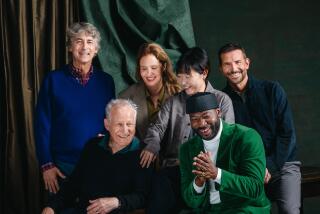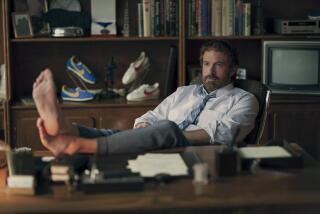BMW at Intersection of Art and Commerce
- Share via
BMW is the driving force behind a series of short Internet films from some of the world’s most acclaimed directors, including Ang Lee, John Frankenheimer, Wong Kar-Wai and Guy Ritchie, all aimed at promoting the German auto maker.
But no one’s calling the project--five, five-minute Internet filmlets collectively called “The Hire”--an ad campaign. And it isn’t product placement per se, although the films--which feature such actors as Clive Owen, Madonna and Forest Whitaker--clearly showcase various models of BMW. Perhaps the best word for it is advertainment, the seamless synthesis of advertisement and entertainment.
In each film, Owen (“Croupier”) plays the suave, sophisticated driver hired to safely, swiftly transport precious human cargo. Behind the wheel of a different BMW in each film, his perilous job--predatory vehicles tend to be in hot pursuit--is always a resounding success thanks to the dazzling performance of the BMW. Owen provides the debonair mystique, the directors provide their refined artistic vision and BMW provides the money.
Two of the films--by Lee and Frankenheimer--are currently online at the BMW site (https://www.bmwfilms.com) after debuting last week; the site received 100,000 hits in its first two days online, according to BMW. The other three films are scheduled to go online in the near future. Each of the films also has a “Sub Plot” directed by Ben Younger (“Boiler Room”) that allows viewers to access secret passages through the story line of each film.
Does this mark the beginning of a new era of corporate filmmaking, where the main goal isn’t art but commerce? No, insist those involved, who say the Internet is forging a new kind of filmmaking.
“Compare this with Hollywood or any filmmaking--this has more freedom,” Lee said.
“With film, you have more obligations. It’s much more investment, you have the studio watching over you, you have an audience,” said Lee, whose latest film, “Crouching Tiger, Hidden Dragon,” just won four Oscars. “For Chinese films you have to deal with censorship.”
“Film has a lot of restrictions,” he said, adding that this project gave him more freedom than any other film he had ever done. BMW would not disclose the total budget for the five films in the Internet series, but Lee said he had a budget of more than $2 million to work with for his film.
The restrictions here (dents and oil drips were frowned upon by BMW) were ones Lee felt he could work with. He enjoyed the challenge of working within what he calls “the gray area of high art and supply art.” Since BMW didn’t want the films to look like commercials, didn’t want the camera to close in on their logo, Lee felt his task was to work “tracelessly, but still make people want to buy the car.”
Steve Golin, whose L.A.-based multimedia development and production company, Anonymous Content, produced “The Hire,” thinks audiences will respond positively to this soft, image-driven sales approach.
“If the product placement is subtle and if the content is entertaining, people don’t care that they’re being marketed at,” he said. “If the content is not entertaining, they care. A lot of commercials irritate people because they’re not entertaining.”
Actor Owen stressed that “the whole BMW thing isn’t overplayed, they’re not shooting a logo every two minutes.”
After the heat his art-house film “Croupier” generated last year, Owen initially wondered whether peddling BMWs was a move in the right direction. But after reading the “quality scripts” and learning of the other talent who had already signed on, Owen determined that “these were proper, full, little five-minute movies,” he said. “It’s just that the films happen to be set in very cool, sexy BMWs.”
While BMW has a history of high profile product placement (for example, the introduction of the BMW Z3 roadster in the James Bond film “GoldenEye”) Owen feels that the fact that the viewer has to go to BMW’s site makes the project aboveboard.
“It’s not like anyone is being duped,” he said. “It’s a bold new way of advertising really.”
*
In fact, “brand-sponsored content,” as Steve Golin likes to call “The Hire,” is as old as television. Today, many gripe that the World Wide Web is nothing but a World Wide Commercial and that securing eyeballs for advertisers is the first and last concern.
At the dawn of TV, soap operas got their name from the soap that was hawked by the show’s sponsors, who exercised a good deal of control over the shows themselves, which essentially existed to fill the space between commercials. The practice has become so well understood that David Mamet mocked producers suffering from slippery integrity in his Hollywood industry comedy “State and Main.” In the film-within-a-film, a dot-com company manages to get anachronistic product placement in a 19th century story.
Entertaining or not, sneaky selling can annoy. But Golin says that for “The Hire,” he had insisted “we weren’t going to let the tail wag the dog.” The tail, however, would have to be an integral element. Golin said the concept was to devise a series “where the car is kind of a character in the film.”
Because of the films’ length, they couldn’t be shown in commercial slots on TV, and premiering them on the Internet seemed like an ideal way to introduce an “event quality,” Golin said. Another advantage to screening them online is that viewers will be just a click away from accessing dealership information. (Later on, the films will be direct-mailed to BMW owners, and screened in BMW showrooms and theaters in Europe.)
Since it was unfeasible to do one long film on the Internet, given today’s bandwidth constraints, the series’ executive producer David Fincher (director of “Seven” and “Fight Club”) devised the idea of producing five short films, each starring a different model of BMW, each with its own director. For Owen, working back-to-back with Frankenheimer, Lee, Ritchie, Wong Kar-Wai and Alejandro Gonzalez Inarritu proved to be “like a mini-film school,” a crash course (as it were) in auteur theory, up close and interactive.
“Something I’ve always known about filmmaking--but this just absolutely confirmed it--is that there are no rules,” said Owen. “Each of these guys comes with their own angle.”
In Lee’s film, “The Chosen,” Owen’s driver protects a young Tibetan Buddha played by Lee’s 8-year-old son, Mason Lee. Owen describes Lee’s work as “mysterious and elegant.” Departing from the bamboo forest chases and rooftop flying in “Crouching Tiger,” Lee choreographed a balletic car chase propelled by baroque music.
Owen describes Frankenheimer (“The Manchurian Candidate”) as “the king of the car chase.” And Golin compares the speeding BMW in Frankenheimer’s short film to the fast and furious car chases in “Ronin,” the director’s 1998 thriller. In “Ambush,” Frankenheimer’s BMW film, Owen chauffeurs an elderly man who fears his pursuers will stop at nothing to get his diamonds. Furious car chases ensue.
But no car manufacturer paid to get its vehicle hyped in “Ronin,” and Frankenheimer says he has never done product placement. Referring to “Ambush,” he says, “This is not product placement. This is a movie sponsored by and funded by BMW to really showcase their cars.”
Golin said that some directors like to shoot a commercial as a warmup before starting a new feature project.
Lee said he chose to work on the project as a creative break from all the social and publicity obligations that followed the success of “Crouching Tiger.” Frankenheimer said that a commercial or short film like this one “really hones your discipline. You can’t waste any time. You can’t waste a shot.”
Lee stressed that the short form also allowed him to be more impressionistic than a feature narrative would allow. “Movies have a very enclosed world. It has to have a beginning, middle and end,” he said. Here, “you just give a gust of creative energy and you get to do whatever you like. You don’t have to give everything to the audience, you can allow them to guess more than a popular movie [in which] you have to deliver certain things. . . . It’s more about provoking thoughts.”
For “The Hire,” the chance to work with desirable art-house directors was the big draw for many of the actors, according to Golin. For the newlywed Madonna, who appears as a spoiled rock star who gets her comeuppance, the chance to work with her husband, Guy Ritchie (“Snatch”), was no doubt appealing. Forest Whitaker leapt at the opportunity to work with Wong Kar-Wai (“In the Mood for Love”) on his segment, which also features Mickey Rourke.
And while no names have been announced thus far, there’s been “incredible reaction,” Golin says, from big stars to work with Mexican director Inarritu (“Amores Perros,” nominated for an Oscar for best foreign language film).


